

Or, it may refer to an opaque edge or area placed between an image and a photosensitive surface to prevent its exposure to certain portions of the image. An example of this is a frisket.
And, it may be used as a verb: to cover in order to conceal, protect, or disguise.
Examples:
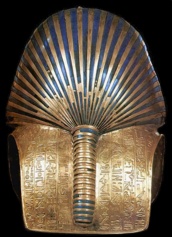

Egyptian, Mask of King Tutankhamen, front and back,
gold and inlaid stones,
weight 22.5 pounds (11 kg),
Cairo Museum, Egypt. The Egyptian pharoah named Tutankhamen reigned from
1347 to 1337 BCE
(New Kingdom, 18th Dynasty). His tomb was opened in 1922. See Egyptian art.

China, Ceremonial Axe with Mask Decoration,
12th/11th century BCE,
bronze, Museum für Ostasiatische
Kunst, Berlin. See Chinese
art.
![]()
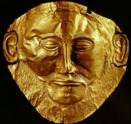
Greece, Ancient Gold Mask from Mycenae, Grave Circle A, Thessalonika Museum, Greece.
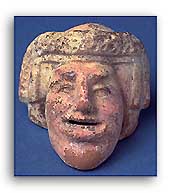
Greece, mask of a "happy youth", terra
cotta miniature,
Michael C. Carlos Museum, Emory U, Atlanta, GA. This is a likeness
of a mask typical of of the sort actors wore in ancient
Greece.
Greek, Attic, Black-Figure Eye Cup with Ships, Archaic, c. 530 BCE, terra cotta, Michael C. Carlos Museum, Emory U, Atlanta, GA. This cup appears to act as a mask when the cup is raised to drink — the eyes staring out, the handles resembling ears, and the foot of the vase appearing as a mouth. The eyes serve an apotropaic function, driving away evil. See black-figure, ex voto, sight, talisman, vessel, and votive.

Roman, A Comic and a Tragic Theater Mask, 2nd
century CE,
marble relief, British Museum, London. On the
left, the comic mask, represented
in three-quarter view,
is bearded, its crowning wreath of ferula (giant fennel) an attribute associated with
Bacchus, the Roman god of theater
(Greek equivalent Dionysos). On the right, the mask of a tragic
character is carved in lower
relief. In ancient
Greece and Rome, every theater mask covered an actor's face entirely,
making a large opening for the mouth necessary to allow the audience
to hear the actor's voice. Each mask's facial features conveyed
an exaggerated expression,
compensating for the fact that the audience
 couldn't
see the actor's own expressions. In the fifth century BCE,
standard mask forms became common for specific roles, with the
specific features of each reflecting the character of the figure
being played.
couldn't
see the actor's own expressions. In the fifth century BCE,
standard mask forms became common for specific roles, with the
specific features of each reflecting the character of the figure
being played.
A contemporary interpretation of masks symbolizing comedy and tragedy.

Italy, Sallet in the Shape of a Lion's Head,
1470-80, steel,
copper-gilt,
glass, polychromy, height
11 3/4 inches (30 cm), weight
8 lb. 4 oz. (3.7 kg), Metropolitan Museum of Art, NY. This mask
was made as armor
for a soldier in the Middle
Ages.

Africa, Nigeria, Edo peoples, Court of Benin,
Pendant Mask: Iyoba, 16th century, ivory, iron, copper,
height 9 3/8 inches (23.8
cm), Metropolitan Museum of Art, NY. See African art and pendant.
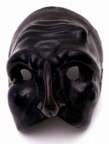
Italian, Mask of Pulcinella, c. 1700, molded leather mask from a Commedia dell'arte theater troupe, The Theatre Museum, London. Pulcinella was traditionally a stupid servant, recognisable from his big beaky nose, hunchback and the wart on his forehead. As the 17th century progressed, the role of Pulcinella
 became more interesting and more diverse. By the time this mask was made, he was not necessarily a servant, but might be a peasant, a dentist, a physician, a painter or a soldier. The mask also changed. Whereas earlier versions had a mustache and beard hiding most of the actor's face, this is a half-mask. Pulcinella was the figure from whom Punch in Punch and Judy puppet shows was derived.
became more interesting and more diverse. By the time this mask was made, he was not necessarily a servant, but might be a peasant, a dentist, a physician, a painter or a soldier. The mask also changed. Whereas earlier versions had a mustache and beard hiding most of the actor's face, this is a half-mask. Pulcinella was the figure from whom Punch in Punch and Judy puppet shows was derived. Here is a view of the back side of the mask.

India, Maharashtra or Karnataka, South Asia, Mask of Shiva, 18th century, repoussé silver, 9 7/8 x 6 7/8 x 2 1/2 inches (25.08 x 17.46 x 6.35 cm), Los Angeles County Museum of Art. See Shiva.

Myochin Muneakira (Japanese, 1673-1745),
Mask, 1745, Edo
period, lacquered iron, height
9 1/2 inches (24.1 cm), Metropolitan Museum of Art, NY. This
mask was made as armor
for a soldier in the Japan.
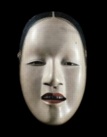
Japan, Nô mask of a young woman, 18th-19th
century, carved and painted wood,
the white paint composed of crushed egg-shells in a binder,
British Museum, London. Nô (also called Noh) is the classical
drama of Japan, with music and dance performed in a highly stylized
manner by masked and elaborately dressed performers on an almost
bare stage. The museum says, "Present-day Japanese Nô
performances adhere to the traditions
established in the fourteenth and early fifteenth centuries by
the masters Kan'ami (1333-84) and his son Zeami (1363?-1443?).
A number of standard masks are used in different dramas. A skilfully
carved mask will appear to have subtle changes of expression
depending on the way in which the wearer turns his head and the
angle at which it is held.
This is one of several variations of a young-woman mask based
on an original design by Zeami, known as Zô-onna.
The false eyebrows painted high on the forehead and the blackened
teeth were fashionable
cosmetic styles
for over a thousand years until the late nineteenth century."
See Japanese
art and theater.

Africa, Cameroon, Eastern Grassfields, Kingdom
of Bamum, Helmet Mask, 19th century, wood,
copper, glass beads, fiber,
cowrie shells, height 26
inches (66 cm), Metropolitan Museum of Art, NY. See African art.

Australia, Torres Strait, Mabuiag Island,
Torres Strait Islander people, Mask, 19th century, turtle-and clam shell,
wood, feathers,
resin, seeds, paint,
fiber, width
25 inches (63.5 cm), Metropolitan Museum of Art, NY.

Sri Lanka, The Serpent Demon, a Kolam dancer's mask,
19th century, pre-1885, height
66 cm, British Museum, London. Sri Lanka is the island once known
as Ceylon to the east of India. Kolam is a rural Sri Lankan form
of drama involving both mime, dialogue, and dance,
by actors who wear masks and costumes. The museum says, "The
characters are divided into several types: humans (for example,
princes, the drummer and his wife, the European), animals and
demons, and the performances move from the depiction of village
scenes to stories involving spirits and fabulous creatures from
Hindu mythology. The
Serpent Demon is a fierce character representing the evil power
of snake poisons that can destroy human and animal life. The
figure can be recognized
partly by the presence of the cobras coiling to form a crown
around its head and the snakes that emerge from its nostrils.
There are several species of poisonous snakes in Sri Lanka; the
cobra in particular is often depicted on demon masks that are
used by dancers in rituals to expel evil from the body of a patient."

Africa, Ivory Coast, Senufo peoples, Mask, 19th-20th century, wood,
horn, fiber,
cotton, feather, metal,
sacrificial material, height
of mask 14 1/8 inches (35.9 cm), Metropolitan Museum of Art,
NY. See African
art.

Africa, Nigeria, Lower Cross River, Ejagham
peoples, Headdress, 19th-20th century, wood,
leather, metal, bone, fiber,
paint, height 10 31/32 inches
(27.8 cm), Metropolitan Museum of Art, NY. See African art.

Burkina Faso, Yatenga region, Mossi peoples,
Mask with Female Figure (Karan-wemba),
19th-20th century, wood, metal, height
29 1/2 inches (74.9 cm), Metropolitan Museum of Art, NY. See
African art.

Viktor Nikolaevich Deni (Russian, 1893-1946), Antanta pod maskoi mira (The Entente under the mask of peace), 1920, 55 x 40 cm, New York Public Library. In this poster, published by the young communist government of Russia during that country's civil war (1918-1922), is a stereotypical fat capitalist who hides behind a mask of peace when he actually supports the defeat of communism. See propaganda.
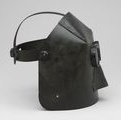
![]()
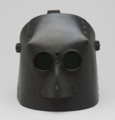
American, manufactured by American Optical Corp., Southbridge, MA, Welder's Mask, before 1930, coated cardboard, glass, bakelite, and metal, 9 x 9 x 7
 inches (22.9 x 22.9 x 17.8 cm), Museum of Modern Art, NY.
inches (22.9 x 22.9 x 17.8 cm), Museum of Modern Art, NY.
Eugene Walter (American), Welder's Mask, 1980, fiberglass and plastic, 12 1/2 x 8 x 7 1/2 inches (31.8 x 20.3 x 19.1 cm), Museum of Modern Art, NY.

Ernest C. Higgins (American), manufactured by Ernest C. Higgins Co. (Allan Follet), Norwood, MA, Goalie Mask, 1964, fiberglass, 10 1/2 x 7 3/4 x 5 3/16 inches (26.7 x 19.7 x 13.2 cm), Museum of Modern Art, NY.

Montien Boonma (Thai, 1953-2000), Self-Portrait:
A Man Who Admires Thai Art, 1982, photograph
altered with decorative
patterns drawn
in colored ink. "The results transform his image
into a traditional Thai
theater mask while also giving it a smirky, challenging version
of the welcoming 'Siamese smile' of tourist industry
cliché," said
Holland Carter, New York Times, Feb. 21, 2003. See self-portrait.
![]()
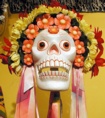
Zarco Guerrero (American, 1952-), Flower Calaca. This is a mask designed to celebrate the Mexican holiday Día de Los Muertos (Day of the Dead). See death.

Felix (Freddy) Aguilar (Bolivian, contemporary)
(who copied a mask designed,
commissioned and danced
by Jorge Vargas in 1984), Diablada (Dance of the Devils) dance mask
from the Andean mountain town of Oruro, Bolivia, 1985, British
Museum, London.
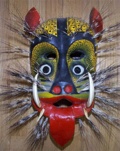
Mexico, Jaguar Mask, 1998, wood,
paint, leather,
boar's hair and teeth. A person wearing this mask could look
through holes placed above the painted eyes of the jaguar.

Maker unknown, Mask worn by WWE Wrestler Rey Mysterio Jr. [real name: Oscar Gonzalez Gutierrez, American, 1974-], 2004, paint on leather? In traditional Mexican wrestling — lucha libre — unmasking is the most powerful thing a wrestler can do to his opponent, because it reveals his hidden identity.

Abelardo Morell (American, born Cuba, 1948-), The Metropolitan Opera: Romeo and Juliet Masks, 2005, black and white photograph of masks used in operatic performances. See music and theater.
Hayley (American, contemporary, at age 11), Flora, 2005, plaster, papier-mâché, tempera, glitter, rhinestones, silk flowers, and acrylic gloss medium, collection of the artist. See an online gallery of masks made by Hayley and her classmates.
https://inform.quest/_art
Copyright © 1996-![]()